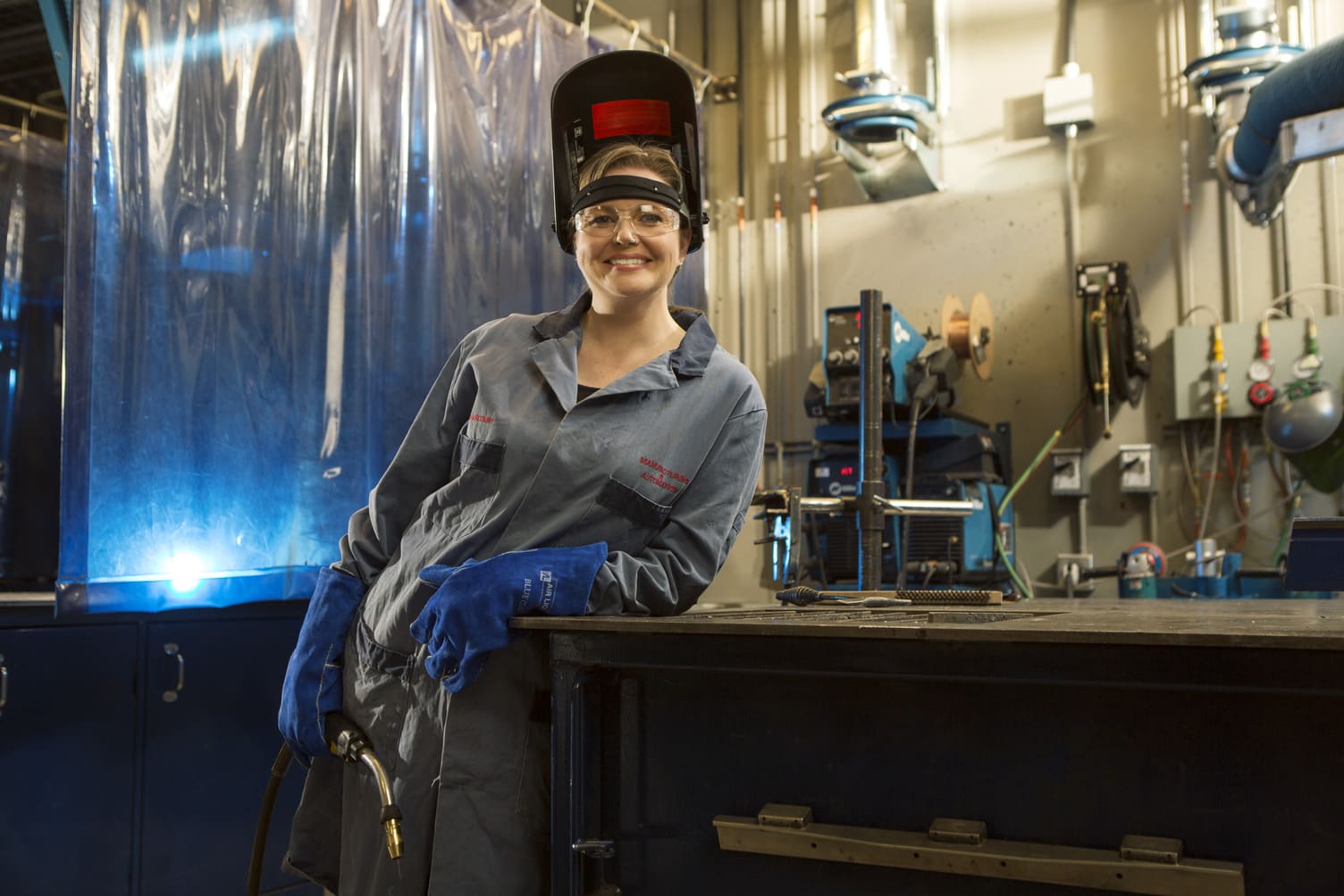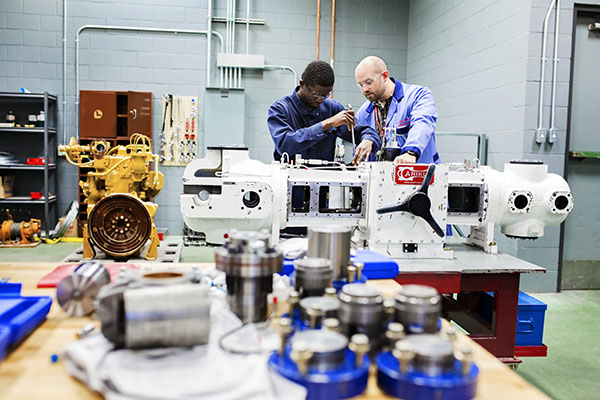On this page:
Overview
Learn how to install, maintain, repair and troubleshoot stationary industrial machinery and mechanical equipment in sites such as factories, production plants and recreational facilities.
As an industrial mechanic, you'll read diagrams and service manuals to figure out work procedures on different kinds of equipment. You'll operate rigging equipment and dollies to place heavy machinery parts as you assemble or disassemble equipment.
To make sure systems and equipment are working properly, you'll fit bearings, align gears and shafts, attach motors and connect couplings and belts to precise tolerances, align and test equipment, make necessary adjustments, perform predictive and operational procedures and repair or replace defective parts.
During your apprenticeship training, you'll also learn about tack welding and the service and repair of hydraulic and pneumatic systems.
Industrial mechanics (millwrights) are self-motivated and work independently. This line of work is fulfilling if you enjoy working on a wide variety of tasks and completing precision work.
To succeed in this trade, you should:
- be able to visualize a layout by looking at plans and prints
- enjoy problem-solving and are creative
- enjoy working on large machinery
- keep up with trends in technology pertaining to the trade
- be able to comprehend and troubleshoot mechanical systems
- have mechanical aptitude
- have good coordination and manual dexterity
- be able to work well with and supervise others
- be committed to safe work habits.
Upon successfully completing the required working hours and technical training periods, you'll be awarded an advanced diploma in addition to journeyperson status by Alberta’s Apprenticeship and Industry Training.
This is a Red Seal Endorsed trade – a recognizable standard that allows tradespeople to work across Canada.
Careers and opportunities
Our graduates may work in the following occupations. Some careers require additional experience and education.
Associated National Occupational Classification (NOC) codes: 72400, 72020, 22301.
Apprenticeship training
The term of apprenticeship for an industrial mechanic (millwright) is four years (four 12-month periods), including a minimum of 1560 hours of on-the-job training and eight weeks of classroom instruction each year.
Year 1 | Period 1
You'll learn about legislation, communication and apprenticeship development. You'll then cover tools and fasteners, measurements, drawings, layouts, machining, machine installation and alignment.
Training length: 8 weeks
Year 2 | Period 2
You'll learn bearings and lubrication, cutting, welding, metallurgy, quality assurance, power transmission and cross dial alignment, process pumps, mechanical seals and compression packing.
Training length: 8 weeks
Year 3 | Period 3
You'll learn compressors, fluid power, fans, heat exchangers, industrial refrigeration and dryers, leveling, alignment and pipe strains.
Training length: 8 weeks
Year 4 | Period 4
You'll learn about stationary engines, turbines and governors, process piping systems, conditioning monitoring, balancing and advanced alignment, mechanical systems with electrical controls, material handling and career development.
Training length: 8 weeks
Apprenticeship education performance
You must pass each section of the course and the AIT exam to succeed in apprenticeship education.
The passing grade for each period is no less than 50% in each course, with no less than a 65% average overall. A passing mark on each provincial exam and the interprovincial qualification (Red Seal Exam) is 70%.
View Alberta's Apprenticeship and Industry Training procedures
Training pathways
You can earn your journeyperson designation in the following ways.
The traditional training pathway begins with finding a job with an employer willing to indenture you as an apprentice. Once you are an apprentice, you'll alternate between on-the-job training and educational periods.
You must apply for an apprenticeship through Alberta Apprenticeship and Industry Training before attending your first education period at SAIT.

Pre-employment pathway
SAIT’s Pre-employment Industrial Mechanic (Millwright) program prepares you to enter into an apprenticeship with hands-on skills. Upon successfully completing the program, you’ll qualify to challenge the first-year Industrial Mechanic (Millwright) apprenticeship exam.
Admission requirements
To enter an apprenticeship, you must have the educational qualifications required or recommended education for the trade to which you apply.
Entrance requirements are monitored and set by Alberta Apprenticeship and Industry Training.
Minimum requirements
Successful completion of the following courses:
- English 20-2
- Math 20-3
- Science 10
OR
A pass mark in all five Canadian General Educational Development (GED) tests
OR
Alberta Apprenticeship and Industry Training Entrance Exam
Recommended requirements
Apprentices with an Alberta High School Diploma that includes the following courses:
- English 30-2
- Math 30-3
- Physics 30 OR Chemistry 30 OR Science 30

MyTradeSecrets
Once you have begun working as an apprentice, you can attend SAIT to complete your technical training.
You'll register for technical training at SAIT on MyTradeSecrets or you can register by phone.
Transfer agreements
At SAIT, we have created transfer agreements with partner institutions to allow you to earn course credits toward your SAIT program based on your previously completed credentials.
Transfer Alberta search tool
Use the Transfer Alberta search tool to see all transfer agreements between Alberta post-secondary institutions (including those with the University of Calgary, Mount Royal University and Bow Valley College.)
Search transfer agreements in Alberta
There are no formal transfer agreements currently in place for this program.
Transfer options for graduates
When you have completed this program, you may continue your education at a partner post-secondary institution. These transfer agreements include partnerships within and/or outside of Canada.
Credits this program transfers to
- Available credits:
- 45
As a certified tradesperson with at least one year of full-time work experience in the field and the necessary English and introductory business prerequisites, you can apply to the University of the Fraser Valley’s Bachelor of Business Administration for Trades Management.
This five (5) semester program complements your prior learning with the fundamentals of business management theories and practices. This will help you successfully function as a manager or owner of a trade-related business in today's rapidly changing global environment.
- Available credits:
- 57
- Available credits:
- 60
Available intakes
Costs
2025/26 tuition and fees
The following costs are effective as of July 1, 2025.
This is a bring-your-own-device program with a standard computer hardware and software requirement. See the specific requirements on our computers and laptops page.
Books or modules, along with other items for classes, are approximately $600 per period.
We recommend you don't purchase books or modules ahead of time as they might be outdated by the time you attend classes, and they cannot be returned to the Bookstore.
Personal protective equipment (PPE) will be required for the program, which may be an additional cost to apprentices.

Funding options for apprentices
Apprentices get to learn while they earn, but there are still costs to consider. Many resources are available at SAIT and federally to help support apprentices.
Information sessions
Prepare for a strong start in your chosen program or get the details you need to decide your future path.
Our expert staff and faculty are ready to answer your questions and provide information about the following:
- What sets SAIT apart
- An introduction to the program and area of study
- Admission requirements
- Future career paths
- Information on the earning potential and graduate employment rates.
Contact
Have more questions?
Technical training at SAIT
School of Manufacturing and Automation
-
Phone - 403.284.8641
-
Email - ma.info@sait.ca
Apprenticeship training and registration
Apprenticeship and Industry Training Client Services

Oki, Âba wathtech, Danit'ada, Tawnshi, Hello.
SAIT is located on the traditional territories of the Niitsitapi (Blackfoot) and the people of Treaty 7 which includes the Siksika, the Piikani, the Kainai, the Tsuut’ina and the Îyârhe Nakoda of Bearspaw, Chiniki and Goodstoney.
We are situated in an area the Blackfoot tribes traditionally called Moh’kinsstis, where the Bow River meets the Elbow River. We now call it the city of Calgary, which is also home to the Métis Nation of Alberta.
